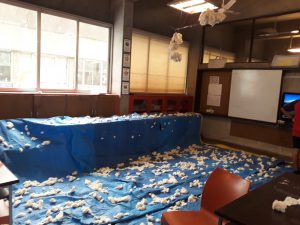- I learnt these things about the Language used with reference to the culture of the country that I explored.
The cultures that my group was exploring were that of Scandinavia and the Inuit people. Although my group didn’t get a specific continent, the regions we got were similar in terms of low temperatures and their proximity to the Arctic region. My group created a bunch of stuff:
- Menu
- Recipe Book
- ‘Virtual’ Museum
- Guide to become a Scandinavian
- Instagram Post
- Myth-busting presentation
- Christmas Wreath
- Photo Booth
The aspect of language was prominent in most of the activities above. In the process of making and thinking of these pieces, I learn a lot about how language can be reflected through culture, and culture can be reflected through language. This was a great way for me to realise, understand, and apply what we learn in Part 1 of the English course to a certain project.
- This is how I attempted to incorporate my ‘Language in Cultural Context’ learning into my project
While thinking of ideas and making these projects, language played a big part. We needed text to represent something as arbitrary as a country’s culture. It seemed like a challenge in the beginning but it turned out to be rather easy. I tried to think of ideas in which aspects of the region’s culture, such as food, art, beliefs, lifestyle, etc. could be incorporated. The menu and recipe book were a way to display food, the ‘virtual’ museum and Christmas wreath was a way to display art and belief (most of these artworks had a superstitious belief that inspired them), the guide and the presentation showed aspects of the lifestyle of the regions. Through these texts, my group was able to convey ideas about the culture we were given. One more aspect of language that I maintained was to remain respectful to the cultures, since conveying something about a culture in another language might become disrespectful if care is not taken. For example, the Inuit people could also be known as Eskimos, however, that term is offensive to them.
- These are the things I did well in my Project
The work that my group produced was up to mark in terms of the criteria that was set, and we were also successful in making a number of different texts. I gave many innovative ideas to my group after researching about the cultures. Along with ideas, I put in most of my effort in motivating and pushing the group’s members to do the work assigned to them. This helped a lot in the completion of the project since some members in the group were giving the SAT, and the final exams were also coming up, so it was rather difficult to get the members enthused enough to even begin their work sometimes. Since I was also giving the SATs, I couldn’t be on the day of the event since the timings clashed, however, I was able to contribute a lot to our group with my work behind the scenes.
- These are areas on which I could have worked to improve my process or final product(s).
With the primary goal and focus of language in mind, the comparative shortage of artistic people, and the scarcity of certain resources, there was a lot of stuff that I wanted to do which I couldn’t. From making an Inuit costume to using clay to recreate the artworks, there were a bunch of ideas that I wasn’t able to execute. Also, unlike some other groups, we focused more on creating the text types, and in the process weren’t able to create artworks to beautify the project. This was one of the reasons our group received comparatively low votes, coupled with the misunderstanding on the day of the event of the name of our group being Antarctica (my group was assigned the continent of Antarctica, however since there were no inhabitants living in Antarctica, we ended up choosing Scandinavia and the Inuit region. However, on the day of the event, the poster that my group made was of Antarctica. So I believe that if I was there, I would have communicated this misunderstanding to my group)
- The CAS learning outcome that I met through the project is/are:
L1 – Identify own strengths and develop areas for growth:
I learned a lot about leadership and handling issues of lack of motivation in members during this project. I had an argument with one of the group leaders. I learned a lot about being considerate and understanding through that argument.
L3- Initiate and plan a CAS experience:
I was a project assistant (group leader) and was part of the planning team for this event.
L4-commitment to and perseverance:
Since school exams and the SAT were on the way, taking time to do all of this was rather difficult for me. And the argument I was talking about was also taking up a lot of my time and energy. However, all of these investments ended up with me learning a lot about leadership and myself, along with making the event a success.
L5-. Demonstrate skills and benefits of working collaboratively,
Working in a group had a lot of benefits in term of the division of work, which is how we were able to make a lot of stuff to present. The abilities of a member matched the work he/she was assigned, resulting in a proper completion of work.
L7-Recognize and consider the ethics of choices and actions
As I mentioned before, language can be offensive sometimes, and we had to take care in the authentic and sensitive representation of our culture. Background research and careful assessment of the texts is how I made sure I was keeping this into consideration.
